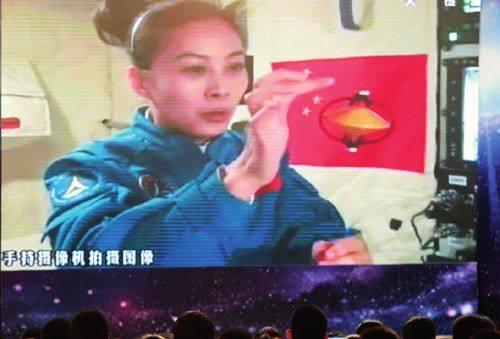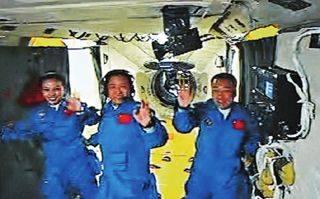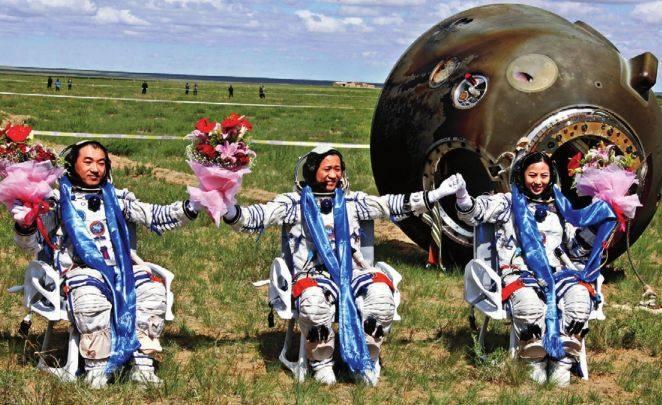China’s Fifth Manned Space Exploration
By staff reporter HOU RUILI
ON June 11, Shenzhou-10, Chi- nas fifth manned spacecraft, lifted off from Jiuquan Satellite Launch Center in Gansu Province, for a 15-day mission in low Earth orbit. A safe reentry and touchdown on June 26 marked the success of the mission and saw the crew go into the record books for the longest manned space flight in Chinas history.
Over the course of the mission, the Shenzhou-10 craft was docked to Chinas Tiangong-1 trial space laboratory module for 12 days, during which the three Chinese astronauts carried out extensive scientific experiments in space technology and medical astronautics. The crew was also the first in China to give a live lecture on the peculiarities of the zero-g environment to a group of excited students back on Earth.
Chinese President Xi Jinping voiced his congratulations on the successful launch of the Shenzhou-10 during a speech at the Launch Center.
Chinas fifth manned space mission came only a decade after its first. In 10 years, the countrys manned space program has developed in leaps and bounds. Shenzhou-10 marked the beginning of the space program entering an applicationoriented phase. The success of the latest mission has laid foundation for building a comprehensive transportation system to ferry payloads and astronauts between space laboratories, launch sites on earth, and eventually, space stations.
Breakthroughs
During the mission Shenzhou-10 docked with Tiangong-1 twice, once automatically and once with manual input from the crew. On June 25, following separation from Tiangong-1 at 7:05 a.m. Beijing time, Shenzhou-10 returned to Earth after successfully conducting a fly-around and rendezvous test with Tiangong-1.
The successful fly-around and rendezvous was Chinas first ever such test, and a valuable experience and key techno- logical triumph that will aid in the building of a space station in the future. Wu Ping, spokeswoman for Chinas manned space exploration program, explained that a fly-around requires the spacecraft to change its orbit and adjust its flight path again and again, an extraordinarily complicated task.
The eventual construction of a space station is a key goal in Chinas space exploration plans. The space station will consist of three sections – one core unit and two experiment modules, arranged into a T-shaped configuration. According to plans, the core unit will feature two fully integrated frontal docking ports. There will be an additional docking port at the rear of the station, used primarily for cargo supply.
The successful Shenzhou-10 mission also pushed forward the development and improvement of Chinas state-of-theart space technology. The spacecrafts solar panels marked one significant innovation. “Improvement of the space solar cell arrays is an important step,”said Wang Zhiyi, a scientist with the No.8 China Astronautic Technology Institute.“We put much work into optimizing the polymer glue and curing processes in order to maximize the efficiency-to-weight ratio of the cells.” With the success of the mission and the solar panels, Wang was singled out for commendation by Chinas space body.
There were many other technological advancements realized during the Shenzhou-10 mission. For instance, the mission utilized a much more effective system of surveillance camera monitoring than that of Shenzhou-9, thus enabling clearer, wider-ranged and more effective monitoring of the spacecrafts condition throughout the launch process.
Worth mentioning is that more and more of the equipment now used in Chinas space missions is designed, developed and produced in China. Domestic investment in space technology research and development is now beginning to pay off, according to Wang.
“Shenzhou-10 was [Chinas] first application-oriented spaceflight, and so its main task was the conducting of scientific experiments,” said Tao Jianzhong, a senior research fellow with the Shanghai Space Technology Institute. According to Tao, about 30-odd scientific experiments took place aboard Shenzhou-10, tripling those on Shenzhou-9. These experiments related not only to the technology of the spacecraft and medical astronautics, but also to pursuing further progress in Chinas Beidou navigation satellite system project and ocean research satellite capabilities.
Lecture from Space
One highlight of the mission was a 40-minute physics class given by astronaut Wang Yaping aboard Tiangong-1, which was broadcast live on June 20 to more than 60 million students and teachers in 80,000 middle schools across the country. Besides demonstrating principles of weightlessness and the surface tension of fluids in the space, Wang, the countrys second female astronaut, answered questions from 330 school kids watching from a classroom at a middle school affiliated with the Renmin University of China in Beijing. The two other astronauts in her crew, Nie Haisheng and Zhang Xiaoguang, provided assistance. China is the second country after the United State to have conducted a live “space lecture.”
The Shenzhou-10 mission was long, and the crew members workload demanding. Measures were taken prelaunch to ensure the astronauts living conditions during the flight were conducive to their consistent performance. Wang, Nie and Zhang had more meal choices during the missions than before them, for instance. A work-sleep timetable was drafted with help from interdisciplinary experts. The astronauts consequently had more downtime than in earlier missions. Special consideration was given to waste disposal by equipping domestic waste disposal units with an array of different technologies. During their stay in Tiangong-1, the three astronauts also rearranged the floor of the space lab and performed related “renovations” to expand the space available for astronauts on future missions to live and work.
Space-tech Put to Use
Though many people in China – and indeed the world – are enthralled by the new progress in mankinds space exploration, there is still lots to learn and technological barriers to overcome before we start sending missions deeper into space. But in the push to solve these problems, people do benefit: space technology trickles down into distinctly terrestrial uses.
According to Tao Jianzhong, for example, the solar cell conversion rate on Shenzhou-10 reached about 26 percent, leading the world. It is expected that further advancements in solar cell efficiency will eventually result in lower power costs on earth. Another example: high quality lubricating oil is a must for spacecraft, and Chinese scientists developed a variety of such substances for the Shenzhou series. Advanced techniques learned in the production of high quality lubricating oil will find commercial application in civilian industries such as aerospace, automobile production and even white goods.
It is common knowledge that spacecraft design requires a suite of advanced, durable materials. The development and deployment of Shenzhou-10 has resulted in many new materials and techniques being pioneered. Wang Kunsheng, president of the China Astronautic System Science and Engineering Institute, said about 80 percent of the 1,100 new mate- rials developed in China in recent years were first and foremost developed for –and used in – the space industry.
“Considering the long periods astronauts are working and living in space, Chinese scientists and medical experts have had to find ways to protect them from bone loss and muscular atrophy. Their innovative approaches to the problems are of high value for civilian use, since on earth these medical problems have been headaches for both bedridden patients and their doctors,” said Chen Shanguang, director of the Research and Training Center for Astronauts.
Academician Hu Wenrui of the Chinese Academy of Sciences pointed out that Chinas biopharmaceuticals industry is far behind its Western counterpart. However, taking advantage of biological science experiments in space, the industry in China may stand a chance of catching up.
Across the board, many techniques developed for astronauts have already been taken up in civilian fields. For example, the manufacturing of some forms of fast food and synthetic clothing materials is based on technical know-how developed for space.
Young Pioneers
Contributing to the success of the Shenzhou-10 mission was a legion of young scientists and engineers from 110 organizations, and 3,000 support units in nine scientific fields. Mou Yu, 31, was a head electrical designer on the Long March 2F, Shenzhou-10s carrier rocket. As one of the lead designers of the rocket, Mou, along with his team at the China Academy of Launch Vehicle Technology (CALT), was responsible for dozens of technical innovations that substantially increased systems design reliability. Mou entered the Beijing Institute of Technology in 2000, majoring in aircraft design. Upon graduation with his Ph.D. in 2007, he began working with CALT, home to many young scientists. Those in their 30s, including Mou, number 17,000, accounting for 80 percent of total staff.
Almost as young as Mou from CALT is Liu Ning, aged 33. Lius role is also of vital importance to Chinas space program: he is a chief designer of the orbiting space lab Tiangong-1. Liu graduated from Tsinghua Universitys Department of Mechanics in 2008 with a doctoral degree. He entered the China Academy of Aerospace Science and Technology with glowing recommendations from his tutors at Tsinghua, and joined the Shenzhou program immediately.
With strong encouragement from the government, universities in China in recent years have been fast tracking outstanding young scientists to enter the space program. At present, around 1,000 young men and women are doing masters or doctoral studies research programs at the China Academy of Aerospace Science and Technology. Those born in the 1980s account for more than 90 percent of the total.
Statistics reveal that of the 150,000 scientists and engineers working in the space industry, 100,000 are 31-33 years old. Yu Menglun, an aerospace mechanics and rocket design expert, said, “The magic of Chinas rising so quickly into space is on the back of youth. Well, and the government.”
Movin On Up
Wang Zhaoyao, spokesman for the countrys manned space program, said that the Shenzhou-10 mission marks consecutive successes for the country. With Shenzhou-10s touching down back on earth, Wang added, China has successfully concluded the “first phase of the second step” of its manned space program.
This “first phase, second step” was approved in February of 2005 and aimed to make technical breakthroughs in astronauts extravehicular activities, and in rendezvous and docking technologies.
Previously, the successful launches of Shenzhou-5 and Shenzhou-6 meant the country was ready to launch manned spacecraft and begin conducting application-specific experiments in orbit.
The period from 2005 till now has seen five launches, including Tiangong, Shenzhou-7, Shenzhou-8, Shenzhou-9 and Shenzhou-10. The five launches saw technical breakthroughs in extravehicular activities, automatic and manual docking maneuvers, and target module testing. The technical support system to guarantee astronauts safety and work efficiency while in orbit has also been greatly improved.
According to Wang Zhaoyao, China plans to launch its Tiangong-2 space lab around 2015. Its launch will be valuable in gaining experience to build a manned space station. According to design plans, the core unit of the Tiangong-2 space lab, which will be a key section of a future space station, will be launched around 2018. In the run-up to the space stations being fully operational, a number of automated cargo and manned flights are anticipated. By 2020, China should have, for all intents and purposes, a functioning manned space station.

